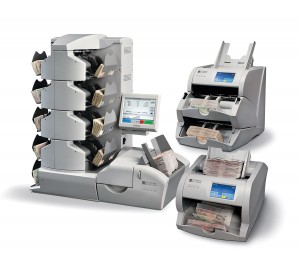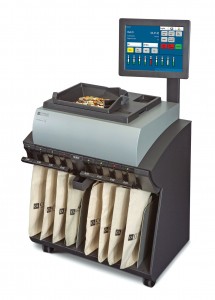Changing face of cash
A new £1 coin and more redesigned banknotes are coming. Is your operation prepared?
Smartcards and contactless payments are widely touted to be the future of PCV payments, having taken off in a big way already. However, cash is almost certainly going to be staying with us for the foreseeable future, a position being reinforced in March 2017 when the Royal Mint is due to introduce the new £1 coin. 2017 is also scheduled to see new polymer £10 notes circulated, in addition to the £5 notes already made from this material. With the design of our money changing, how will it affect cash handling equipment used in the industry? With the help of Cummins Allison, Chris Peat finds out.

The release of the polymer £5 note has helped raise awareness of the upcoming introduction of the new £1 coin.
Pound not round for long
The £1 coin as we know it will not be round (literally!) for much longer, with its replacement due to enter circulation in March 2017. This shouldn’t come as a surprise since the change was originally announced in the 2014 budget. It will be quite a momentous transformation for loose change though, as the current incarnation of the currency was first issued in 1983, making it one of the oldest British coins in circulation. However, over time it has become increasingly vulnerable to counterfeiting. Roughly one in every 30 £1 coins in circulation is now a forgery, claims the Mint. Security features on the new £1 include a hologram-like image that changes from a ‘£’ symbol to the number ‘one’ when the coin is seen from different angles.

Although these old £1s will be phased out, there will be a six month period of grace where the existing £1 and the new £1 coins will co-circulate.
The Royal Mint is producing over 1.4bn of the new £1s ready for their introduction. Following their launch, there will be a six month period where the existing £1 and the new £1 coins will co-circulate. After these six months are up, the existing £1 will lose its legal tender status. The removal from circulation of the old variation will begin in March.
The new edition will be a 12 sided, bi-metallic, bi-colour coin (similar to the £2 coin) with milled edges. With an edge thickness of 2.8mm and a diameter of 23.43mm from point to point (23.03mm edge to edge), it will weigh 8.75g.
How prepared are we?
Both the Royal Mint and HM Treasury have been working closely with cash handling equipment companies to ensure the transition to the new £1 is smooth. As with any coinage changes, the Mint suggests that all businesses that handle cash will need to plan and prepare for the new coin, ensuring they are aware of the changes required to their network of coin handling equipment. So, how prepared is the PCV industry for this?
Sales Manager at cash handling machine specialists, Cummins Allison, Paul Clay, said, ‘We have been informing our customers about the imminent release of the new £1 coin for many months now, with regular mailings, emails and articles on our website. We have found that some people are ahead of the game and have already upgraded their coin processing equipment. Others are in the process of upgrading now and will be ready in time; however, we are concerned that there are some businesses that have not made any provision for upgrading their coin counting and sorting machines prior to the release of the new coin. We urge everyone who uses coin counting machines, whether they are currently a Cummins Allison customer or not, to get in touch with us as soon as possible so we can help guide them towards the best machine for their needs and ensure their business does not see any downtime when the new coin is released.’
What may have alerted some to the change in currency is the recent introduction of the new polymer £5 note. Paul said, ‘Many newspapers and online news sources covered the release of the polymer note and I think this helped raise awareness of the other changes to come. Once people have handled one, they are more likely to want to find out about its features and how to check if it’s genuine. In the process of doing that, they are likely to find out about the new £1 coin and the polymer £10 note. One aspect that I don’t think has been given enough coverage is the fact that the paper £5 note ceases to be legal tender on 5 May 2017, not that far away!’
Problems
With the new £1 coin, Paul envisions the problem will be the co-existence of the two variations of the coin over the initial six month period. It will mean companies will have to handle two coins of the same denomination. Paul said, ‘Obviously, if businesses have not upgraded their coin processing equipment before the switch-over, they are going to experience problems and decreased productivity as the new coin will be have to be manually separated.’

The JetScan iFX series of cash counters and sorters can be used to deal with the new polymer £5 note.
‘That’s why we are urging people to upgrade now and minimise this disruption. For consumers, this could be a difficult and confusing period where some businesses and service operators accept new £1 coins and others don’t, everything from parking meters to shopping trolleys and gym lockers will be affected.’
In addition to this issue, another challenge Paul foresees for the bus industry is any potential confusion the general public has around the new currency. ‘The equipment used in the bus industry, from initial contact with the customer through to processing takings, needs to be fit to handle the new currency, both polymer notes and new £1 coins. Getting every stage of the coin handling process updated, upgraded and ready for the new currency is vital to ensure smooth running of operations for customers and employees,’ said Paul.
Cummins Allison can help in terms of dealing with the new cash. In particular, it has experience dealing with polymer notes and their unique handling properties in Canada and Australia. All of its note processing machines are polymer-ready, so they can handle the new UK notes. Paul said, ‘In regards to the new £1 coin, if you buy a machine from Cummins Allison now, it will also be ready for the new currency. If you currently have a Cummins Allison machine, or a machine from a different provider, it is vital to contact us as soon as possible, some coin machines will require a hardware upgrade which can be carried out by one of our engineers, however older machines will need replacing. We are able to advise you on the best course of action and have some excellent offers on new machines, so it is the perfect time to upgrade.’
Clear communication
Businesses need to ensure that they and their employees can deal with the situation, Paul advises, both in recognising the new and old currencies and advising customers who are unlikely to have access to the same degree of preparation. Paul said, ‘Clear communication with customers is important, to reassure them about what currency you accept, that the change you may give is legal tender and so on. With so many changes at once, eliminating the chance for human error is also important. Without reliable technology, staff may make mistakes that result in them miscounting cash or unwittingly accepting forged currency.’
